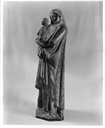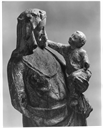Statuette of the Virgin and Child
Gothic, Medieval, Gothic Period, ca. 1140-1500 CE, Medieval
late 13th century
54.61 cm x 17.78 cm x 19.05 cm (21 1/2 in. x 7 in. x 7 1/2 in.)
wood and polychrome
BZ.1912.2
Not on view
Permalink:
http://museum.doaks.org/objects-1/info/27438
Description
This very animated treatment of the Virgin and Child was typical of the High Gothic period and was particularly prevalent in the Ile-de-France region. The Dumbarton Oaks example represents an important iconographic development in the Middle Ages, which is reflected in the portal statuary of the thirteenth-century cathedral façades at Paris and Amiens. Up until about 1200, the pair was often seated and enthroned. Standing, the Virgin is newly interpreted as the Bride of Christ (Sponsa Christi) and a symbol of the Church (Ecclesia). Her coronation in heaven by an adult Christ replaces the earlier, traditional depiction of the infant Christ seated on his mother’s lap, the Throne of Wisdom (Sedes sapientiae).
In this less hieratic positioning of the Virgin and Child, the pair is both crowned and frontal, therefore retaining the formality appropriate to their sacred status. Yet the intimate relationship between the two is immediately apparent. Thirteenth-century literature, both religious and secular, emphasized the humanity of both the Mother and Child. The more animated, individualized depiction of the pair, smiling tenderly at one another, conveys this new attitude of devotion. Empathizing with the Mother of God as she contemplates her son, the contemporary viewer would have had a more direct, personal experience.
From a figural perspective, another important development is apparent. The principle of contrapposto is adapted here for the standing Virgin, who gracefully supports her Child on her raised left hip. This courtly stance, prominent in French cathedrals, encouraged hundreds of similar versions. Judging from its size, the Dumbarton Oaks example likely adorned a private chapel and was the focus of daily repetition of the Hours of the Virgin.
The Virgin stands on a hexagonal base, her right leg slightly flexed and her weight supported on her left leg. Her left foot emerges from beneath her gown at the center of the base. Around this main axis her body describes a graceful curve and counter curve, animating the group with a gentle swaying motion. Vertical lines predominating in the drapery folds of the (proper) left or weighted side of figure are opposed by the softer curving folds that wrap the lower right side of the body and sweep upward to the arm that supports the Christ child. The Child, riding on his mother's hip, turns his upper body and raises his head to meet her gaze; his right hand reaches eagerly to touch her veil. Over a long-sleeved, high-necked gown, belted at the waist, the Virgin wears a full mantle held by a strap that loops across her breast. Her head is covered by a short veil held in place by a circlet of rosettes. The Child, barefoot and uncrowned, wears a simple long-sleeved gown that falls to his feet. Originally both figures would have held attributes in their (missing) hands, the Virgin a flowering scepter and the Child perhaps an apple.
Bibliography
Arts of the Middle Ages, Boston Museum of Fine Arts (Boston, 1940), no. 173, pl. 38, p. 54.
W. D. Wixom, "Two Thirteenth Century Walnut Angels," in The Bulletin of the Cleveland Museum of Art, vol. LXI, No. 3 (March 1974), pp. 86-87, illus. p. 87, fig. 12.
G. Vikan, Catalogue of the Sculpture in the Dumbarton Oaks Collection, from the Ptolemaic Period to the Renaissance (Washington, DC, 1995), no. 45 (by Dorothy Gillerman), pl. 45A-D.
G. Bühl, editor, Dumbarton Oaks, The Collections (Washington, DC, 2008), p. 296, illus. p. 297.
Exhibition History
Boston, Museum of Fine Arts, "Arts of the Middle Ages," Feb. 17 - Mar. 24, 1940.
Baltimore, Baltimore Museum of Art, "Sculpture and Milles," November 1940.
Cambridge, Fogg Museum, Oct. 1945 - Apr. 1946.
Acquisition History
Purchased from the dealer Georges Joseph Demotte (1877–1923), Paris, no. 5705, by Mildred Barnes and Robert Woods Bliss, December 6, 1912;[1]
Collection of Mildred Barnes and Robert Woods Bliss, 1912 to November 29, 1940;
Gifted to Harvard University, November 29, 1940;
Dumbarton Oaks, Byzantine Collection, Washington, D.C.[2]
Notes:
[1] Bill of sale in Demotte file
[2] Transferred from the House Collection to the Byzantine Collection in the 1980s.





